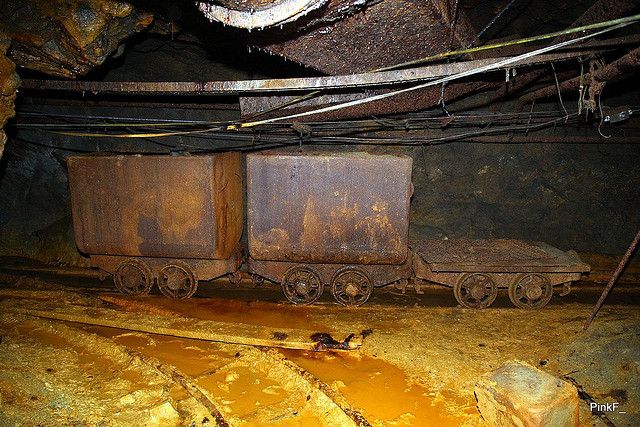The Toxic Legacy Of Abandoned Gold Mines

Table of Contents
Environmental Impacts of Abandoned Gold Mines
Abandoned gold mines represent a significant source of environmental pollution, impacting air, water, and soil quality for decades, even centuries, after their closure. The legacy of irresponsible mining practices continues to threaten both human health and ecological balance.
Water Contamination
Water contamination is perhaps the most pervasive consequence of abandoned gold mines. The oxidation of sulfide minerals, a common process in gold ore, generates acid mine drainage (AMD), a highly acidic and metal-rich solution. This AMD leaches heavy metals such as arsenic, mercury, lead, and cyanide into nearby water bodies, rendering them toxic and unusable.
- Processes leading to contamination: Oxidation of pyrite (iron sulfide) and other sulfide minerals produces sulfuric acid, which dissolves heavy metals from the surrounding rock and soil.
- Examples of contaminated water bodies: Numerous rivers and lakes worldwide show elevated levels of heavy metals due to abandoned gold mine drainage. Specific examples often vary regionally and require more localized research.
- Impact on aquatic life and downstream ecosystems: Heavy metal contamination decimates aquatic life, disrupting entire food webs and impacting downstream ecosystems, even rendering drinking water sources unsafe for human consumption.
Soil Degradation and Erosion
Mining activities drastically alter the landscape, leading to significant soil degradation and erosion. The removal of topsoil, coupled with the instability of mine waste, leaves the land barren and susceptible to erosion. Heavy metals released during mining further contaminate the remaining soil, rendering it unsuitable for agriculture or other land uses.
- Physical changes to the landscape: Stripping of vegetation, creation of open pits and tailings piles, and the disruption of natural drainage patterns contribute to significant landscape alterations.
- Long-term impact on soil fertility: The loss of topsoil and the contamination with heavy metals drastically reduce soil fertility, making it unproductive for decades or longer.
- Risk of dust containing heavy metals: Wind erosion of contaminated tailings and mine waste can spread heavy metal-laden dust over wide areas, posing respiratory risks to humans and animals.
Air Pollution
Abandoned gold mines are not only sources of water and soil contamination but also contribute to air pollution. Wind erosion of tailings piles and exposed mine waste releases dust particles containing heavy metals into the atmosphere.
- Health impacts of inhaling heavy metal-containing dust: Inhalation of these particles can lead to various respiratory problems, including lung cancer and other serious health issues.
- Specific heavy metals found in airborne dust: Arsenic, lead, and mercury are common heavy metals found in dust from abandoned mines.
- Role of wind erosion in spreading contamination: Wind acts as a vector, dispersing heavy metal-containing dust over substantial distances, impacting larger areas than initially affected by mining activities.
Human Health Risks Associated with Abandoned Gold Mines
The environmental damage caused by abandoned gold mines directly translates into significant human health risks, particularly for communities living in proximity to these sites.
Heavy Metal Poisoning
Exposure to heavy metals through contaminated water, soil, or air can cause a range of serious health problems, including:
- Specific heavy metals and their associated health risks:
- Arsenic: Skin lesions, cancer, cardiovascular problems.
- Mercury: Neurological damage, developmental problems in children.
- Lead: Neurological damage, developmental problems in children, kidney damage.
- Cadmium: Kidney damage, bone disease.
- Symptoms of heavy metal poisoning: Symptoms can vary widely depending on the metal and the level of exposure but may include nausea, vomiting, diarrhea, neurological problems, and skin lesions.
- Long-term health effects: Chronic exposure to heavy metals can lead to long-term debilitating health problems, including cancer and organ damage.
Waterborne Diseases
Contaminated water sources near abandoned gold mines are not only poisoned by heavy metals but also pose a risk of spreading waterborne diseases such as cholera, typhoid, and diarrhea.
- Common waterborne diseases: Diarrhea, typhoid fever, cholera, and other waterborne illnesses are common risks in communities using contaminated water sources.
- Vulnerability of children and the elderly: Children and the elderly are particularly vulnerable to the impacts of waterborne diseases.
- Lack of access to clean water: In many areas with abandoned mines, access to clean and safe drinking water is limited or nonexistent, exacerbating the public health crisis.
Occupational Hazards
Even after closure, abandoned mines pose significant occupational hazards for those who inadvertently encounter them, such as children, hikers, or individuals scavenging for scrap metal.
- Dangers of mine shafts and unstable ground: Collapsed shafts, unstable ground, and hidden dangers within abandoned mines pose risks of injury or death.
- Risks of exposure to toxic materials within the mine: Contact with contaminated water, soil, or airborne dust within the mine can lead to acute or chronic heavy metal poisoning.
Remediation and Reclamation of Abandoned Gold Mines
Addressing the toxic legacy of abandoned gold mines requires comprehensive remediation and reclamation efforts. However, this is a complex and costly undertaking.
Current Remediation Techniques
Various techniques are employed to mitigate the environmental and health impacts of abandoned gold mines:
- Water treatment: Techniques such as neutralization, precipitation, and filtration can be used to remove heavy metals and reduce acidity from contaminated water.
- Soil remediation: Methods include excavation and disposal of contaminated soil, phytoremediation (using plants to absorb contaminants), and bioremediation (using microorganisms to break down contaminants).
- Mine sealing: Sealing mine shafts and other openings helps prevent further water infiltration and the generation of AMD.
- Costs and challenges involved: Remediation is a significant undertaking, often requiring substantial financial investment and facing technological challenges specific to each site's unique conditions.
Sustainable Mining Practices
Preventing future problems associated with abandoned gold mines requires a shift towards sustainable mining practices:
- Best practices for mine closure and environmental protection: Regulations mandating proper mine closure plans, including water management strategies, waste rock disposal, and land reclamation, are crucial for preventing future pollution.
- Role of environmental impact assessments and monitoring: Thorough environmental impact assessments before mining operations commence, along with ongoing monitoring during and after mining, are essential for identifying and mitigating potential environmental damage.
- Importance of community engagement: Involving local communities in the planning and implementation of mining projects ensures transparency, addresses community concerns, and facilitates the development of socially responsible and environmentally sustainable practices.
Conclusion
The toxic legacy of abandoned gold mines poses a severe threat to environmental health and human well-being. The widespread contamination of water, soil, and air with heavy metals leads to numerous health problems and ecosystem damage. Addressing this issue requires comprehensive remediation efforts, coupled with a decisive shift towards sustainable gold mining practices. Preventing future abandoned gold mine pollution is crucial for safeguarding human health and the environment. We must all work together to support organizations focused on remediation, advocate for stricter regulations, and promote sustainable practices for gold mining to prevent future tragedies. Learn more about abandoned gold mines in your area and support initiatives working to address this pressing global challenge.

Featured Posts
-
 Where To Watch Gypsy Rose Life After Lockup Season 2 Episode 4 Online Free
May 06, 2025
Where To Watch Gypsy Rose Life After Lockup Season 2 Episode 4 Online Free
May 06, 2025 -
 Official Gregg Popovichs Next Move With The San Antonio Spurs
May 06, 2025
Official Gregg Popovichs Next Move With The San Antonio Spurs
May 06, 2025 -
 New Apple Tv Series Ayo Edebiri And Will Sharpe Play Former Child Stars
May 06, 2025
New Apple Tv Series Ayo Edebiri And Will Sharpe Play Former Child Stars
May 06, 2025 -
 Local Artist Uses Murals To Honor Black Women In Nashville
May 06, 2025
Local Artist Uses Murals To Honor Black Women In Nashville
May 06, 2025 -
 End Of The World Singel Terbaru Miley Cyrus Lirik Musik Dan Video Musik
May 06, 2025
End Of The World Singel Terbaru Miley Cyrus Lirik Musik Dan Video Musik
May 06, 2025
